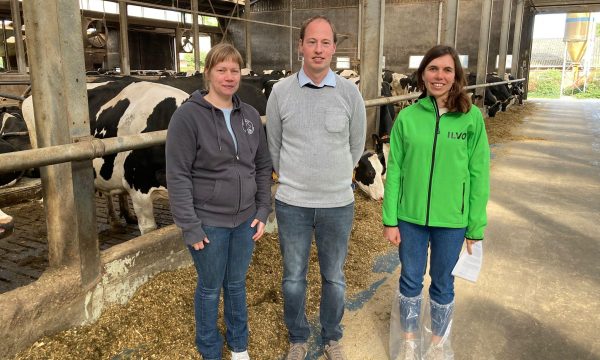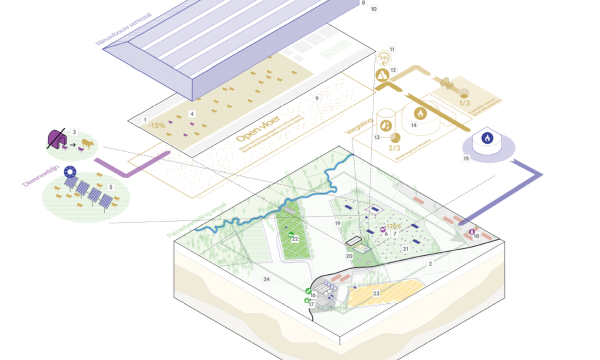Press release Most climate-friendly milk comes from ... Flanders
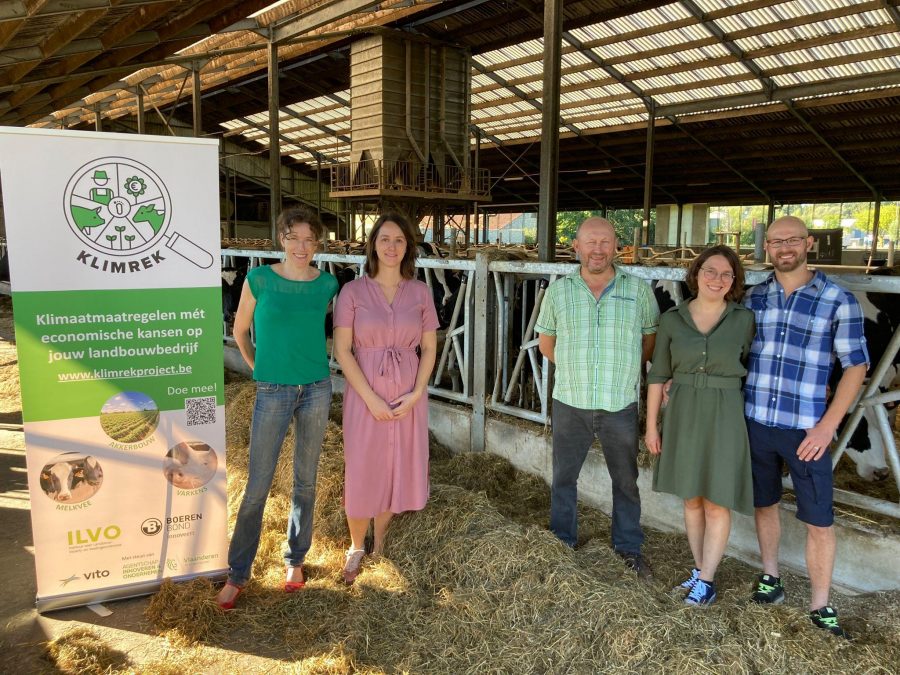
A worldwide comparison of the ecological footprint of milk, carried out by ILVO, shows that no other country produces milk as climate-efficiently as in Flanders.
The study was conducted within the framework of the recently completed VLAIO research project KLIMREK, which aimed to clarify where Flemish farms stand in the climate story, and how they can become more sustainable step by step.
Detailed climate scans on some 150 Flemish dairy farms show that one liter of Flemish milk is on average associated with only 0.99 kg of CO2 equivalents. This is lower than the score of all other milk producing countries.
"We have long been using the superlative 'most climate-friendly' for our milk and this is now once again scientifically substantiated. The fact that the dairy sector is reaching such high peaks, even at the beginning of the rollout of the KLIMREK approach, is encouraging," responded Jo Brouns, Flemish minister of agriculture, economy and innovation. In a dairy barn in Oostkamp, KLIMREK partners ILVO and Boerenbond explained the method and the results.

Farms differ, so individual climate-scans and improvement recommendations are needed
In the KLIMREK project, ILVO researchers and Boerenbond consultants worked together on a farm-specific climate trajectory. This consists of a method designed by ILVO researchers to carry out very detailed climate scans at farm level as well as an advisory trajectory that provides insight into where the farm can improve further.
Veerle Van linden, ILVO LCA expert and project coordinator: "In the scan, we list and quantify all the inputs and processes that contribute to the agricultural product supplied (milk, meat, wheat...). These data go into a Life Cycle Analysis (LCA) and we obtain the total ecological footprint of the farm over 1 year, with a detailed overview divided by process and product flow. The climate impact of imported raw materials (e.g. fertilizers) is also included in the figure. So the origin and possible transformation of the land use of soy in the feed ration is included."
Step two is very important for farmers: a specialized climate consultant discusses their farm scores in comparison to other farms, and above all, advises the farmers about which measures to apply to further reduce their own farm's greenhouse gas emissions. For each proposed climate measure, the possible contributions to other environmental effects, such as acidification or eutrophication, are also calculated in advance, to avoid negative shifts in other environmental themes. Finally, the farmer also receives a cost-benefit analysis per proposed climate measure including yearly follow-ups, a smart, knowledge-based climate trajectory emerges for all KLIMREK farms.
The climate impact of Flemish dairy farms
Until today, 146 dairy farms have been screened using the scan. The footprints range between 0.74 and 1.53 kg CO2 equivalents per kilogram of milk measured. On average, that's 0.99 kg CO2 eq.
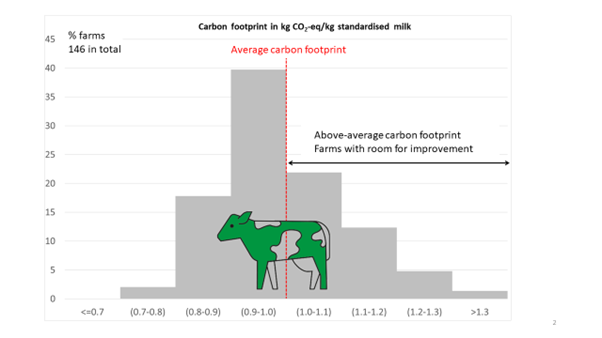
The spread around the average reveals that improvements can still be made.
Veerle Van linden: "Remarkably, we discovered that climate performance is not related to typical farm characteristics (large or small-scale farm, organic or conventional, grazing or not...). Climate-efficient milk production is typology-independent. This means that a tailored scan, with tailored measures, makes sense!
Comparison with other milk-producing countries
With only 340,000 lactating cows, the Flemish dairy herd is small compared to large producers such as India (128 million cows), the United States (9.4 million) and even Germany (3.8 million) and France (3.3 million).
Per cow, milk production in Flanders is high on average (10,278 liters of milk per lactating cow per year). This is due, among other things, to the choice of breed, meticulous farm management in terms of disease prevention and animal welfare, knowledge about grassland management and manure processing and precise ration compositions according to requirements. These factors also influence the ecological footprint.
ILVO did searches of climate data in the specialized AgriFootprint 6.0 database. These obtain their figures by calculating an LCA of the milk from a fictitious average farm, representative of the country in question, according to a uniform method. Everyone also calculates in the same standardized "measuring milk" (FPCM or Fat & Protein Corrected Milk).
The international database already placed Belgian milk in the leading group, close to climate-friendly milk producers Denmark and New Zealand. The top 10 includes almost only European countries. Belgium scores remarkably better than the weighted European average.
The actual impact measurement of Flemish dairy farming, which now appears from a representative series of KLIMREK scans of individual farms (green bar in the table) shows an even more punishing picture: Flanders has the most climate-friendly milk. No other country achieves the same average low climate impact score.
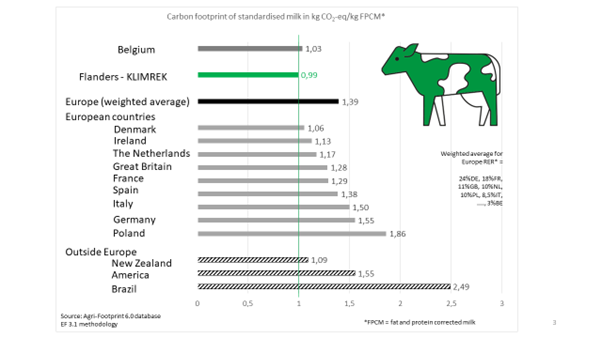
Milk climate score in Flanders keeps improving
KLIMREK possesses a digital calculation tool connected to the most up-to-date calculation factors and methods. The climate consultants are trained (and certified) to develop scenarios based on the weaknesses and strengths of the farm. The farmer gets the predicted climate effects for each proposed measure on a summary page....
Tinkering with cow rations yields the greatest climate improvements. Up to one-tenth of the footprint of milk from Flanders can be eliminated using adusted rations. Feeding beer draff and rapeseed meal to cows has a methane-inhibiting effect on digestion. Some feed supplements with a proven, large methane lowering effect. Replacing overseas soy with local protein sources also makes a big difference.
Spreading less fertilizer on grassland and switching to grass-clover can again reduce several percent CO2 equivalents. Keeping fewer young cattle by increasing the longevity of lactating cows is an option for some farmers.
The overview below shows potential decreases based on an average performing dairy farm (150 cows and 110 young cattle, 26 months to first calving, 30% replacements per year, 64 ha for own forage production in grass, grass silage and corn, 10,500 kg of measured milk per year) that in the climate scan arrived at 1.0 CO2 eq/kg of measured milk.
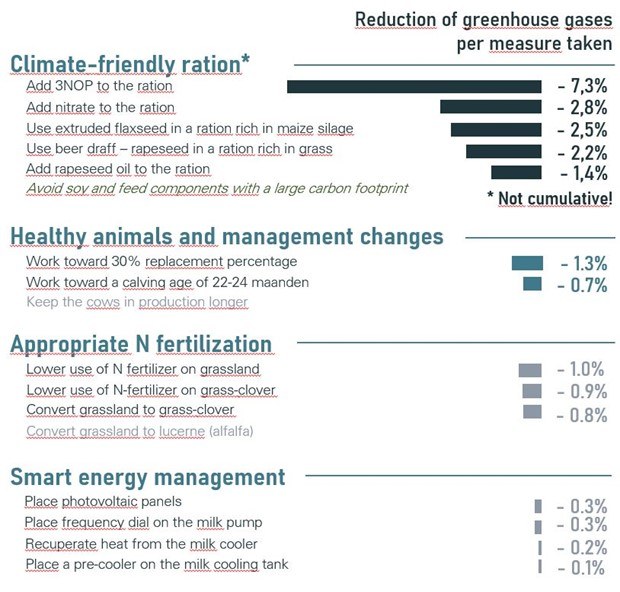
A case from Oostkamp: the milk of Niels and Katleen Keeremans
Niel and Katleen have 100 head of dairy cows that together give 952,989 liters of milk per year. His milk scores well below the Flemish average: 0.88% CO2 eq. /kg of milk measured. The present manure treatment installation (pocket fermentation where methane from manure is converted into electricity and heat in a CHP) makes the farm score very well in terms of manure storage and treatment.
Niels Keereman, Klimrek participant: "That 0.88 is even lower than the 0.99 average of all KLIMREK scans so far. That does make me proud! The cows' digestion could perhaps still be done with less methane emission, by providing different feed. That is part of the KLIMREK recommendations. We get added value by receiving so much information about the operation from the analyses, and also that we can decide for ourselves which measures to take. After all, every change in operations requires time to learn, money and effort..."
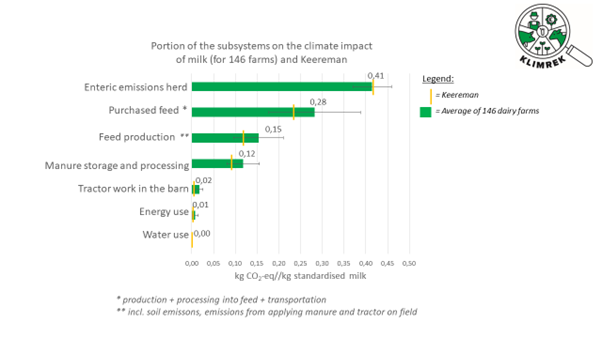
Future plans: a broader rollout!
ILVO promises to continue to maintain the calculation tool after the end of the project, as well as to provide continuous updates based on new products or climate improvement techniques.
MilkBE, the trade association for the Belgian dairy sector, represents both dairy farmers and dairy processors, and says it wants to help stimulate and support a rapid roll-out of the KLIMREK approach to dairy farms in the future. "MilkBE believes that individual climate scans, associated insights and the ability to tailor measures are the way to further make the dairy sector more sustainable. We want to fully commit to the user-friendliness of the scan and digital data links that will make the climate scan even more efficient," said Lien Callewaert, chair of MilkBE's Sustainability Working Group.
Lode Ceyssens, president of Boerenbond: "Boerenbond was a partner in KLIMREK to help develop the method together with a series of pilot farmers. We will also participate ambitiously in the rollout. We could already boast of the high quality of our milk. Now it has been proven that we also produce the most climate-friendly milk. That colors the future for this sector."
Jo Brouns, Flemish minister of Agriculture, Economy and Innovation: "I remember that it is indeed technically possible to reduce the amount of greenhouse gas emissions from a liter of milk and thus from our dairy farming. This is encouraging because this sector, like many others, has predetermined climate targets to meet. I hope that citizens will hear this news and perhaps also start to realize that it matters whether they drink a liter of Flemish milk or one that we have introduced with a higher climate impact."
Klimrek stands for "KLImaatMaatRegelen met Economische Kansen op het landbouwbedrijf. The VLAIO project ran from 2019 to 2023. ILVO was coordinator, Boerenbond and VITO partnered. In the total budget of 1.2B€ (Flemish funding), the 10% co-fund came from the agricultural umbrella organizations Boerenbond, Belgapom, Belpork and BCZ (dairy sector). Over a period of four years, Klimrek has developed tailor-made scanning systems and guidance programs for three subsectors: dairy farming, pig farming and arable farming. Other subsectors now also require a scanning method and climate advice that can be used for them. In 2023, the sectors of field vegetables and (hard) fruits got started. On September 6, 2023, the KLIMREK partners in Melle presented the results and plans for the future rollout in dialogue with the sector and policy, at a concluding KLIMREK event.
